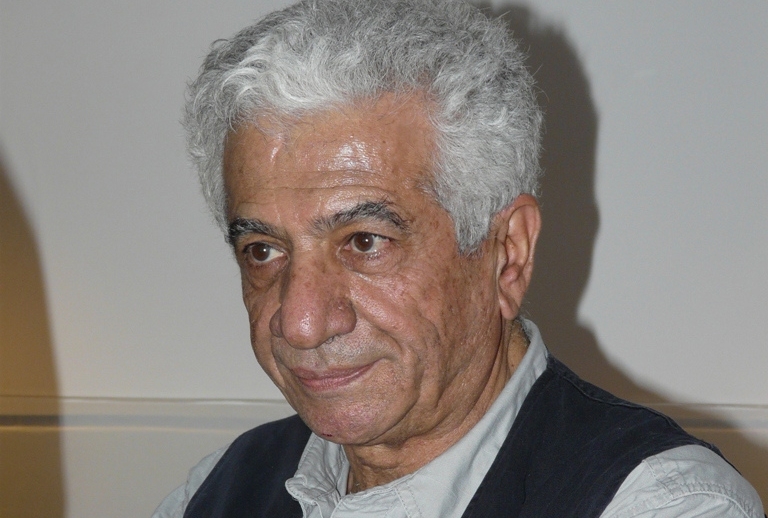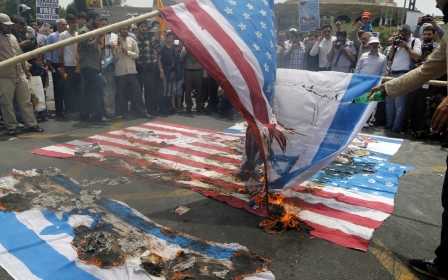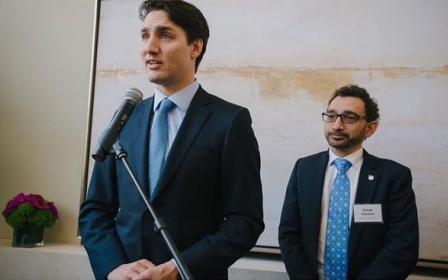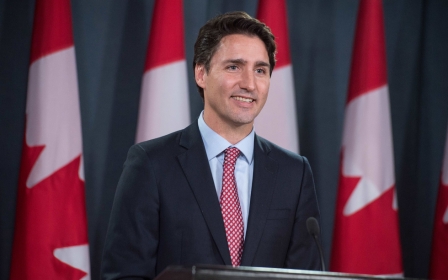Detained Iranian-Canadian artist freed, returns to Vancouver

TORONTO, Canada – Celebrated Iranian-Canadian artist Parvis Tanavoli says he is happy to be back in Canada after Iranian authorities barred him from leaving the country for two weeks.
“I have no idea what was the cause of it, but on 2 July, my passport was confiscated at Tehran airport while I was going to London for two lectures and my book launch,” Tanavoli said.
The artist, who splits his time between Tehran and Vancouver, landed back in the Canadian city on Monday.
He said he still does not know why Iranian police seized his passport. But he was later informed that local officials accused him of “disturbing public opinion” and “spreading lies” through his work, allegations that he told Middle East Eye were categorically false.
“To me, it’s not right. It’s not true,” the 79-year-old said.
“I am happy that all the allegations are removed and I’m back. [In] the last 35 [years] that I’m going back and forth [between Iran and Canada], I haven’t had any experience like this. This is the first time.”
Artwork ‘not political’
Known as “the father of modern Iranian sculpture”, Tanavoli is a sculptor, painter and author. He is well known for his ability to mix cultural and religious folklore with modernist motifs, and his work inspired a movement of Iranian artists in the 1960s.
Tanavoli hosted his first solo exhibition in the United States last year and his piece entitled The Wall (Oh Persepolis) – a bronze sculpture covered in hieroglyphs that stands over two metres tall – sold for $2.84 million at auction at Christie’s Dubai in 2008.
But the artist’s best-known works are perhaps his depictions of the word heech, Persian for “nothing,” which he has represented in countless forms and across various artistic styles.
“I have been creating in the last 50 years in many shapes and many ways,” Tanavoli told MEE.
When his passport was confiscated, Tanavoli was on his way to London to participate in talks at the British Museum and Asia House for the launch of his new book, European Women in Persian Houses.
“Whether this was to them creating anxiety among people or not, I know people love my art. How they defined it, I don’t know,” he said, referring to how the Iranian authorities interpreted his work.
“I went through a lot of anxiety of course, a lot of hard days and pain, because you don’t know why you are detained … That [makes it] even worse,” he added.
Another dual national detained
But Tanavoli is not the only Canadian national to have problems in Iran recently.
Iranian-Canadian Homa Hoodfar also had her passport confiscated in March as she attempted to fly back to Canada. The 65-year-old retired professor has since been detained and held incommunicado at Evin prison in Tehran and accused of “dabbling in feminism and security matters”.
Hoodfar has reportedly been charged with a crime, but her family says it does not know what specific charges have been laid against her.
The Canadian government, meanwhile, says it is “actively engaged” in Hoodfar’s case.
“We are working closely with our like-minded allies in order to best assist Dr Hoodfar,” Rachna Mishra, spokesperson for Canada’s department of foreign affairs, told MEE in an email.
James Devine, a professor at Mount Allison University and an expert on Iran, said “the big problem is what’s happening inside of Iran right now. That’s what’s driving all of this.”
Devine explained that a power struggle is playing out between Iranian President Hassan Rouhani, who is gradually opening Iran up to Western countries, and more conservative leaders inside the country who want a say in Iran’s international affairs.
“They’re using this to try and undermine Rouhani’s position and to undermine his foreign policy,” Devine said.
Canada, meanwhile, has very little influence on what goes on inside Iran, Devine said.
The previous Conservative government of Canada cut diplomatic ties with Tehran in 2013. Although Ottawa says it has restarted talks to re-establish formal ties with the Iranian government, it does not yet have a diplomatic presence in Iran.
“We’re still kind of dealing with the remnants of what’s been happening with Iran and Canada,” Devine said.
Going back to work
Meanwhile in Vancouver, Tanavoli said he plans to return to Iran in a few months to continue his work and train Iranian art students. He said he has trained about 1,000 students throughout his career.
“I cannot leave everything behind. I have a studio with many students and artworks, unfinished artworks,” Tanavoli told MEE, adding that the support his students showed him during this ordeal helped him tremendously.
“My students were the greatest in this matter. They were so beautifully behind me. They remained behind me until the end … They are very loyal to me. How can I give them up?” he said.
He also said he is looking forward to exhibiting his sculptures at the Aga Khan Museum of Islamic art in September, which will mark his first exhibition in Toronto. He also said he has plans to launch “a big show” at the Tehran Museum of Contemporary Art shortly.
“I’m going to be pretty busy while I’m here,” he said. “I will continue with all my work.”
Middle East Eye propose une couverture et une analyse indépendantes et incomparables du Moyen-Orient, de l’Afrique du Nord et d’autres régions du monde. Pour en savoir plus sur la reprise de ce contenu et les frais qui s’appliquent, veuillez remplir ce formulaire [en anglais]. Pour en savoir plus sur MEE, cliquez ici [en anglais].




